Safety at Sea
Safety Equipment for a Yacht

|
List Of Safety Equipment For A Yacht.txt Size : 5.842 Kb Type : txt |
Boating Distress Signals
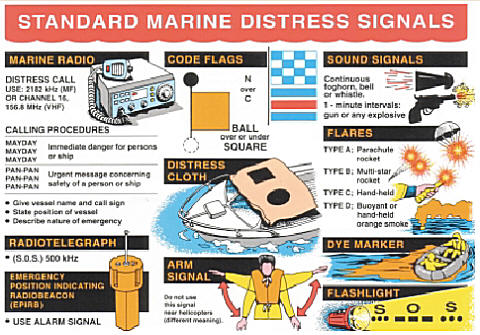
Nato Phonetic Alphabet
Most of the time when using a well set up radio, plain language is adequate. there are times when it is difficult to hear properly and individual words have to be spelled out. in a fuzzy radio the phonetic alphabet can be heard alot better. some letters sound the same so the phonetic alphabet helps. The first letter off the word is the letter it stands for.
Why? Well, let's face it.. there's no dignity in saying "Dog Yeti Nutcase Apple Mother Otter Otter" on the telephone.
Why NATO? The NATO Phonetic Alphabet was developed in the 1950s to be intelligible (and pronounceable) to all NATO allies in the heat of battle. It replaced other phonetic alphabets, for example the US military "able baker" alphabet.
So it's the standard? The NATO Phonetic Alphabet is now widely used in business and telecommunications in Europe and North America. There are dozens of other standards in use throughout the world, but then the great thing about standards is that there are so many to choose from.
A- alpha
B- bravo
C- charlie
D- delta
E- echo
F- foxtrot
G- golf
H- hotel
I- india
J- juliet
K- kilo
L- lima
M- mike
N- november
O- oscar
P- papa
Q- quebec
R- romeo
S- sierra
T- tango
U- uniform
V- victor
W- whisky
X- x-ray
Y- yankey
Z- Zulu
VHF RADIO DISTRESS
MAYDAY– Imminent threat to life!
PAN-PAN – Urgent assistance is required – for this call replace the word
for PAN-PAN
ENSURE THE VHF IS ON CHANNEL 16 AND 25 WATTS/HIGH POWER
DEPRESS THE TRANSMIT BUTTON on hand microphone.
MAYDAY, MAYDAY, MAYDAY
(ALL SHIPS, ALL SHIPS, ALL SHIPS (PAN-PAN ONLY))
THIS IS..(Repeat the vessel’s name three times)
for MAYDAYVessel name spoken once
MY POSITION IS Latitude and Longitude or True bearing and
distance from a charted feature
NATURE OF DISTRESS e.g. sinking, on fire, etc
I REQUIRE IMMEDIATE ASSISTANCE
NUMBER OF PERSONS ON BOARD and OTHER USEFUL INFORMATION
OVER
Release the transmit button and wait for acknowledgement.
Keep listening on channel 16 for instructions
If an acknowledgement is not received repeat the distress call.
CHECK LIST
What You Should Be Able Get Put Your Hands On:
- Lifejackets & Safety Harnesses
- EPIRB (Know how to activate it)
- Ditch Bag (see "what to look for in an offshore boat")
- Life raft and how to deploy
- Emergency Steering (how to set up. Is there a special tool to get access to the steering quadrant? Where is it?)
- Flashlights (keep at least one on deck at night)
- Tools
- Fire extinguishers
- Duct Tape
- Manual Bilge Pump Handles
- Fog Horn
- First Aid Kit
- Spare Oil and Filters
- Extra lashings and tie downs
- Every Seacock (or at least know every location)
- Wooden Plugs & Hammer
- Engine Inlet and strainer: (Know how to clear the strainer)
- Check Engine Fluids (Oil/Transmission)
- How do the belts look?
- Check liquid in the batteries.
- Do you have spare filters and impellers?
- Spare Jerry Jugs of fuel
On Deck:
- A Knife
- Check Turnbuckles
- Check for chafe in furling return lines.
- Check all Halyards are clear and secure.
- How to launch the MOB
- Make sure the anchor is very secure, but know how to deploy it quickly in an emergency.
- Check Running Lights
- Check Compass Light
- (Do you have a backup light for the compass light?)
- Flashlight on deck at night.
What You Should Know How To Do:
- Start (Stop) and operate the main engine
- Reef the sails
- Rig Jack lines
- Understand the Electrical Panel
- Operate the VHF or SSB in an emergency.
- Operate Bilge pumps (both electrical and Manual)
- Garbage Plan - What goes where (Besides an oil pollution placard many boats also require a garbage placard noting what can and what cannot be thrown overboard).
- Rig Preventer
- Release halyards
What To Look Out For:
- Each other
- The boom
- Tripping on deck (one hand for you and one for the boat).
- Don't block the helm when docking, underway in port or near busy channels
- Placing things like open drinks on the counter.
- Know not to turn the battery switch off with the engine is running.
- Don't be afraid to tell the helmsman about anything ahead (Lobster pots, floating logs) or coming up from behind (faster/bigger boats).
- When off watch make sure you get enough rest.
- Make sure to take your seasickness medicine if you are prone.
- Clean up after yourself in the head and galley.
- Make sure to turn off the propane safety switch after using the stove.
- If the boat policy is to keep the main water panel switch off when not in use, make sure it is off.
Lifejackets and Buoyancy Aids
How Are Lifejackets And Buoyancy Aids Classified?
50N Buoyancy Aids – EN393 (11lbs / 5.5kg of buoyancy)
These products are designed for competent swimmers, and are suitable for use in sheltered waters. They will only provide support to a conscious person who can normally help themselves.
• Most common uses are active water sports such as dinghy sailing, board sports, kayaking, and on personal water craft (jet skis).
• A good quality 50N buoyancy aid can usually be bought for less than £50
• There are many styles and fits to suit the requirements of most water sports activities.
100 Newton Lifejacket – EN395 (23lbs / 11kg of buoyancy)
These lifejackets are designed for both swimmers and non-swimmers and are suitable for use around inshore and coastal waters. They give a reasonable assurance of safety from drowning in relatively calm waters.
• These products are NOT guaranteed to self-right an unconscious person wearing waterproof clothing and should not be expected to protect the airway of an unconscious person in rough water.
• Under EU regulations, these lifejackets must be constructed out of a bright coloured fabric with 100cm2 of SOLAS reflective tape stitched to the front and provided with a whistle for attracting attention.
• They are most commonly used on inland waterways and lakes or on the coast by craft operating reasonably close to shore in fair weather and fair sea conditions.
• These jackets are often constructed in a foam waistcoat-style, making them simple to fit and relatively maintenance-free.
• Prices are around £30 to £40.
150N Lifejacket – EN396 (33lbs / 16kg of buoyancy)
These lifejackets are suitable for both swimmers and non-swimmers, and are designed for use in inshore as well as offshore and in all but the most severe conditions.
• They give reasonable assurance of safety from drowning, to a person not fully capable of helping themselves (ie someone unconscious).
• However they may not immediately self-right an unconscious person wearing heavy waterproof clothing that might trap air that could counter-act the normal righting moment of the lifejacket’s buoyancy.
• These lifejackets can be constructed out of foam (looking very similar to the orange foam lifejackets seen on ferries), or they can be of a low profile gas inflation design.
• Under EU regulations, these jackets must be constructed out of a bright coloured fabric (when inflated) with 300cm2 of SOLAS reflective tape stuck to the front and provided with a whistle for attracting attention.
• The EN396 150N gas inflation model lifejacket is the most popular type sold in the UK, particularly for leisure craft such as yachts and motor cruisers where their lower profile design is valued for being unobtrusive and easy to wear.
• They can be supplied in both manual activation (inflated by pulling a toggle) and automatic water-activated models which inflate when they are submersed in water.
275 Newton Lifejacket - EN399 (62lbs / 28kg of buoyancy)
These lifejackets are suitable for both swimmers and non-swimmers and are designed to provide a high performance device for offshore and severe conditions, when maximum protection is required or where heavy waterproof clothing is worn that can trap air.
• These products give improved assurance of safety from drowning, to people who are not able to help themselves (ie unconscious).
• While they cannot be guaranteed to immediately self-right an unconscious person wearing heavy waterproofs that might trap air, the buoyancy that they provide should ensure that they will do so in the majority of cases.
• Under EU regulations, these products must be constructed out of a brightly coloured fabric (when inflated) with 300cm2 of SOLAS reflective tape stuck to the front and provided with a whistle for attracting attention.
• The 275N gas inflation model lifejacket is popular on leisure vessels that travel further offshore or on ocean passages in challenging conditions and also by smaller commercial operators that do not need to comply with full SOLAS lifejacket regulations but want the assurance that the improved performance offers.
• The low profile design is also valued for being unobtrusive.
• These jackets are normally supplied in automatic water-activated models which inflate when they are submersed in water.

Key Times Life Jackets Should Be Worn:
-
Non-swimmer when on deck
-
When preparing to abandon the boat
-
In fog when the is a danger of collision
-
In dingies when wearing heavy water proof clothing
-
Children near the water line (on the pontoon as well as on board the boat)
-
If the crew feel more confident and comfortable with one on
-
At any time the skipper orders
Fires
For hot, fat fires a fire blanket should be used to smoother the flames. If a fire blanket is not immediatly available, a wet tea towel is better than nothing. Place fir extinguishers by all exits so people can grab them while on there way to the deck.
A- Suitable for fighting wood, paper etc.
B- Suitable for flammable liquids(oil and fuel, NOT for big, hot fires)
C- Suitable for flammable gases.
Anchoring and Anchors
Types Of Anchor:
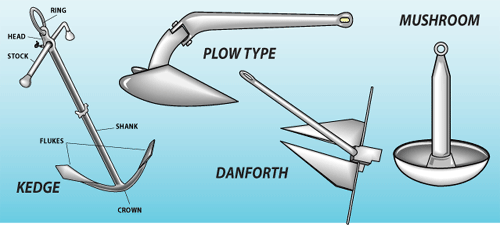
How To Anchor:
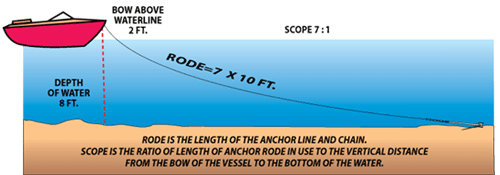
Flares
Handheld Smoke Flares:
Used for pinpoint your position to the rescue services and other boats. generally they work and submit smoke for about 60 seconds and can be seen upto seven miles away.
Mini Flare Packs:
These also assist in pinpointing a position- Visable upto five miles away by day and ten miles away by night.
Parachute Flares (Red or White):
These are ones for attracting attention in the first place. they fire a rocket upto 300m in the air and are visable for upto 28 miles, the parachute drops slowly and the flare burns in the air for around 40seconds.
Lite Smoke:
These are very helpfull for pinpoint a position in bright sun light. they can be visable for sven miles and can be also thrown onto the water to pinpoint a man over board.
Buoys
The port (left) and starboard (right) buoys when entering port or going up an estuary to a harbour or port, are port marker bouy - red, and starboard marker buoy - green. these bouys also have a flashing light, the same colour as the buoy is in day light.
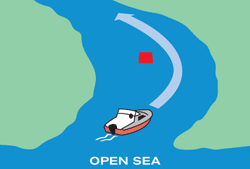
KEEP red (port hand marks) on your left hand side (to port) when going upstream.

KEEP green (starboard hand marks) on your right hand side (to starboard) when going upstream.

KEEP red (port hand marks) on your right hand side (to starboard) when going downstream
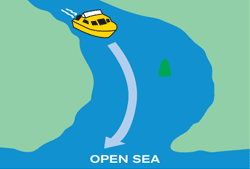
Lateral Marks:
Used generally to mark the sides of well-defined, navigable channels.
They are positioned in accordance with a Conventional Direction of
Buoyage. They indicate the Port and Starboard hand sides of the route
to be followed. They are coloured Red (Port Hand Marks) and Green
(Starboard Hand Marks).
General Direction of Buoyage
Around the British Isles the General Direction of Buoyage runs North
along the West coast and through the Irish Sea, East through the English
Channel and North through the North Sea (the opposite in IALA system B,
for example in the USA).
Cardinal Marks
Used in conjunction with the compass to indicate the direction from the
mark in which the deepest navigable water lies, to draw attention to a
bend, junction or fork in a channel, or to mark the end of a shoal. The
mariner will be safe if they pass North of a North mark, South of a South
mark, East of an East mark and West of a West mark.
Cardinal Marks are also used for permanent wreck marking whereby North,
East, South and West Cardinal buoys are placed around the wreck. In the
case of a new wreck, any one of the Cardinal buoys may be duplicated
and fixed with a Radar Beacon (RACON).
Isolated Danger Marks
Used to mark small, isolated dangers with navigable water around the
buoy. Typically used to mark hazards such as an underwater shoal or rock.
They are coloured Black and Red.
Safe Water Marks
May be used mid-channel, as a centreline or at the point where land is
reached. These buoys (as the name suggests) indicate the presence of safe,
navigable water all around the buoy. They may also indicate the best point
of passage under a fixed bridge. These buoys are coloured Red and White.
Special Marks
Not primarily intended to assist navigation but are used to indicate a
special area or feature, the nature of which is apparent by referring to
a chart or Notice to Mariners. Special Marks are used in the marking of
cables and pipelines, including outfall pipes and recreation zones. Data
Buoys are also classed as Special Marks. They are coloured yellow.
Emergency Wreck Buoys
These buoys provide a clear and unambiguous means of marking new
wrecks. This buoy is used as a temporary response, typically for the first
24 - 72 hours. This buoy is coloured in an equal number of blue and
yellow vertical stripes and is fitted with an alternating blue and yellow
flashing light.
Night Safety
Be Bright – Be Safe At Night
When night falls it is a completely different world on the water and so vessels that operate from sunset to sunrise, whether at anchor or underway, must carry and exhibit the correct lights.
BOATING AT NIGHT: GO slow, BE seen, KEEP a lookout and BE bright.
Go Slow
When fog, glare, smoke or darkness restricts your visibility, you must slow down to a safe speed. A safe speed is one at which you can stop and avoid a collision, considering the circumstances and conditions at the time.
You wouldn’t drive fast on a dark road without headlights – the same applies on dark waterways – be bright.
Remember – the faster you go, the faster you approach hazards and hitting a hazard at speed can have a greater impact on you, your passengers and your boat.
Be Seen
You may be able to see others but can they see you? At night, every type of craft on the water needs lights in order to be seen. Whether you are paddling, rowing, sailing or motoring, everyone needs to be able to recognise where you are and what you are doing.
Make sure you have the right lights for your craft and that they work properly. Use them as soon as the sun goes down or when visibility is poor. Your lights should be mounted in a position that gives you optimum night vision and allow others to see you from every direction.
You must carry a working waterproof floating torch. It may help others see you if you shine your torch on your sails or superstructure.
Make sure you don’t adversely affect your night vision, or the vision of other boat skippers.
For more Info on Safety At Night and Light please view the next chapter in the Navigation Bar, Called.. Navigation.